Direct Quantification of Cd2+ in the Presence of Cu2+ by a Combination of Anodic Stripping Voltammetry Using a Bi-Film-Modified Glassy Carbon Electrode and an Artificial Neural Network
Abstract
:1. Introduction
2. Materials and Methods
2.1. Reagents and Instrumentation
2.2. Preparation of Bi-Film-Modified Glassy Carbon Electrode (GCE)
2.3. SWASV Detection of Cd2+ in the Presence of Cu2+
2.4. ANN Modelling
2.5. Preparation of Soil Samples
3. Results and Discussion
3.1. Optimization of Experimental Conditions
3.2. Electrochemical Characteristics of the Bi/GCE
3.3. Influence of Cu2+ on the SWASV Detection of Cd2+
3.4. Effects of Ferricyanide on the SWASV Detection of Cd2+
3.5. Proposed ANN Model for the Cd2+ Detection in the Presence of Cu2+
3.5.1. ANN Model Optimization
3.5.2. Establishment and Validation of the Improved ANN Model
4. Conclusions
Supplementary Materials
Acknowledgments
Author Contributions
Conflicts of Interest
References
- Sofu, A.; Sayilgan, E.; Guney, G. Experimental design for removal of Fe(II) and Zn(II) ions by different lactic acid bacteria biomasses. Int. J. Environ. Res. 2015, 9, 93–100. [Google Scholar]
- Gumpu, M.B.; Sethuraman, S.; Krishnan, U.M.; Rayappan, J.B.B. A review on detection of heavy metal ions in water—An electrochemical approach. Sens. Actuators B Chem. 2015, 213, 515–533. [Google Scholar] [CrossRef]
- Fu, F.; Wang, Q. Removal of heavy metal ions from wastewaters: A review. J. Environ. Manag. 2011, 92, 407–418. [Google Scholar] [CrossRef] [PubMed]
- Zhang, Q.X.; Wen, H.; Peng, D.; Fu, Q.; Huang, X.J. Interesting interference evidences of electrochemical detection of Zn(II), Cd(II) and Pb(II) on three different morphologies of MnO2 nanocrystals. J. Electroanal. Chem. 2015, 739, 89–96. [Google Scholar] [CrossRef]
- Yao, X.Z.; Guo, Z.; Yuan, Q.H.; Liu, Z.G.; Liu, J.H.; Huang, X.J. Exploiting differential electrochemical stripping behaviors of Fe3O4 nanocrystals toward heavy metal ions by crystal cutting. ACS Appl. Mater. Interfaces 2014, 6, 12203–12213. [Google Scholar] [CrossRef] [PubMed]
- Liu, Z.G.; Chen, X.; Liu, J.H.; Huang, X.J. Robust electrochemical analysis of As(III) integrating with interference tests: A case study in groundwater. J. Hazard. Mater. 2014, 278, 66–74. [Google Scholar] [CrossRef] [PubMed]
- Liu, Z.G.; Chen, X.; Jia, Y.; Liu, J.H.; Huang, X.J. Role of Fe(III) in preventing humic interference during As(III) detection on gold electrode: Spectroscopic and voltammetric evidence. J. Hazard. Mater. 2014, 267, 153–160. [Google Scholar] [CrossRef] [PubMed]
- Xu, R.X.; Yu, X.Y.; Gao, C.; Liu, J.H.; Compton, R.G.; Huang, X.J. Enhancing selectivity in stripping voltammetry by different adsorption behaviors: the use of nanostructured Mg-Al-layered double hydroxides to detect Cd(II). Analyst 2013, 138, 1812–1818. [Google Scholar] [CrossRef] [PubMed]
- Wang, J. Stripping Analysis: Principles, Instrumentation, and Applications; VCH Publishers: Weinheim, Germany, 1985. [Google Scholar]
- Chinowsky, T.M.; Saban, S.B.; Yee, S.S. Experimental data from a trace metal sensor combining surface plasmon resonance with anodic stripping voltammetry. Sens. Actuators B Chem. 1996, 35, 37–43. [Google Scholar] [CrossRef]
- Zhao, G.; Yin, Y.; Wang, H.; Liu, G.; Wang, Z. Sensitive stripping voltammetric determination of Cd(II) and Pb(II) by a Bi/multi-walled carbon nanotube-emeraldine base polyaniline-nafion composite modified glassy carbon electrode. Electrochimica Acta 2016, 220, 267–275. [Google Scholar] [CrossRef]
- Zhao, G.; Wang, H.; Liu, G.; Wang, Z. Simultaneous and sensitive detection of Cd(II) and Pb(II) using a novel bismuth film/ordered mesoporous carbon-molecular wire modified graphite carbon paste electrode. Electroanalysis 2017, 29, 497–505. [Google Scholar] [CrossRef]
- Zhao, G.; Wang, H.; Liu, G.; Wang, Z.; Cheng, J. Simultaneous determination of trace Cd (II) and Pb (II) based on Bi/Nafion/reduced graphene oxide-gold nanoparticle nanocomposite film-modified glassy carbon electrode by one-step electrodeposition. Ionics 2016, 23, 767. [Google Scholar] [CrossRef]
- Zhao, G.; Wang, H.; Liu, G.; Wang, Z. Simultaneous determination of Cd (II) and Pb (II) based on bismuth film/carboxylic acid functionalized multi-walled carbon nanotubes-beta-cyclodextrin-nafion nanocomposite modified electrode. Int. J. Electrochem. Sci. 2016, 11, 8109–8122. [Google Scholar] [CrossRef]
- Liu, Z.G.; Huang, X.J. Voltammetric determination of inorganic arsenic. TrAC Trends Anal. Chem. 2014, 60, 25–35. [Google Scholar] [CrossRef]
- Sun, Y.F.; Chen, W.K.; Li, W.J.; Jiang, T.J.; Liu, J.H.; Liu, Z.G. Selective detection toward Cd2+ using Fe3O4/RGO nanoparticle modified glassy carbon electrode. J. Electroanal. Chem. 2014, 714, 97–102. [Google Scholar] [CrossRef]
- Zhu, L.; Xu, L.; Huang, B.; Jia, N.; Tan, L.; Yao, S. Simultaneous determination of Cd(II) and Pb(II) using square wave anodic stripping voltammetry at a gold nanoparticle-graphene-cysteine composite modified bismuth film electrode. Electrochimica Acta 2014, 115, 471–477. [Google Scholar] [CrossRef]
- María-Hormigos, R.; Gismera, M.J.; Procopio, J.R.; Sevilla, M.T. Disposable screen-printed electrode modified with bismuth–PSS composites as high sensitive sensor for cadmium and lead determination. J. Electroanal. Chem. 2016, 767, 114–122. [Google Scholar] [CrossRef]
- Mafa, P.J.; Idris, A.O.; Mabuba, N.; Arotiba, O.A. Electrochemical co-detection of As(III), Hg(II) and Pb(II) on a bismuth modified exfoliated graphite electrode. Talanta 2016, 153, 99–106. [Google Scholar] [CrossRef] [PubMed]
- Kadara, R.O.; Tothill, I.E. Development of disposable bulk-modified screen-printed electrode based on bismuth oxide for stripping chronopotentiometric analysis of Lead (II) and Cadmium (II) in soil and water samples. Anal. Chim. Acta 2008, 623, 76–81. [Google Scholar] [CrossRef] [PubMed]
- Kokkinos, C.; Economou, A.; Raptis, I.; Efstathiou, C.E. Lithographically fabricated disposable bismuth-film electrodes for the trace determination of Pb(II) and Cd(II) by anodic stripping voltammetry. Electrochimica Acta 2008, 53, 5294–5299. [Google Scholar] [CrossRef]
- Maczuga, M.; Economou, A.; Bobrowski, A.; Prodromidis, M.I. Novel screen-printed antimony and tin voltammetric sensors for anodic stripping detection of Pb(II) and Cd(II). Electrochimica Acta 2013, 114, 758–765. [Google Scholar] [CrossRef]
- Kokkinos, C.; Economou, A.; Goddard, N.G.; Fielden, P.R.; Baldock, S.J. Determination of Pb(II) by sequential injection/stripping analysis at all-plastic electrochemical fluidic cells with integrated composite electrodes. Talanta 2016, 153, 170–176. [Google Scholar] [CrossRef] [PubMed]
- Crowley, K.; Cassidy, J. Trace analysis of lead at a nafion-modified electrode using square-wave anodic stripping voltammetry. Electroanalysis 2002, 14, 1077–1082. [Google Scholar] [CrossRef]
- Torrecilla, J.S.; Rodriguez, F.; Bravo, J.L.; Rothenberg, G.; Seddon, K.R.; Lopez-Martin, I. Optimising an artificial neural network for predicting the melting point of ionic liquids. Phys. Chem. Chem. Phys. 2008, 10, 5826–5831. [Google Scholar] [CrossRef] [PubMed]
- Torrecilla, J.S.; Deetlefs, M.; Seddon, K.R.; Rodriguez, F. Estimation of ternary liquid–liquid equilibria for arene/alkane/ionic liquid mixtures using neural networks. Phys. Chem. Chem. Phys. 2008, 10, 5114–5120. [Google Scholar] [CrossRef] [PubMed]
- Zhu, W.W.; Li, N.B.; Luo, H.Q. Simultaneous determination of Chromium(III) and cadmium(II) by differential pulse anodic stripping voltammetry on a stannum film electrode. Talanta 2007, 72, 1733–1737. [Google Scholar] [CrossRef] [PubMed]
- Hutton, E.A.; Hočevar, S.B.; Ogorevc, B.; Smyth, M.R. Bismuth film electrode for simultaneous adsorptive stripping analysis of trace cobalt and nickel using constant current chronopotentiometric and voltammetric protocol. Electrochem. Commun. 2003, 5, 765–769. [Google Scholar] [CrossRef]
- Wang, J. Stripping analysis at bismuth electrodes: A review. Electroanalysis 2005, 17, 1341–1346. [Google Scholar] [CrossRef]
- Aragay, G.; Pons, J.; Merkoci, A. Recent trends in macro-, micro-, and nanomaterial-based tools and strategies for heavy-metal detection. Chem. Rev. 2011, 111, 3433–3458. [Google Scholar] [CrossRef] [PubMed]
- Bhatti, M.S.; Kapoor, D.; Kalia, R.K.; Reddy, A.S.; Thukral, A.K. RSM and ANN modeling for electrocoagulation of copper from simulated wastewater: Multi objective optimization using genetic algorithm approach. Desalination 2011, 274, 74–80. [Google Scholar] [CrossRef]
- Suah, F.B.M.; Ahmad, M.; Taib, M.N. Optimisation of the range of an optical fibre pH sensor using feed-forward artificial neural network. Sens. Actuators B Chem. 2003, 90, 175–181. [Google Scholar] [CrossRef]
- Ayodele, B.V.; Cheng, C.K. Modelling and optimization of syngas production from methane dry reforming over ceria-supported cobalt catalyst using artificial neural networks and box–behnken design. J. Ind. Eng. Chem. 2015, 32, 246–258. [Google Scholar] [CrossRef]
- Ariza-Avidad, M.; Cuellar, M.P.; Salinas-Castillo, A.; Pegalajar, M.C.; Vukovic, J.; Capitan-Vallvey, L.F. Feasibility of the use of disposable optical tongue based on neural networks for heavy metal identification and determination. Anal. Chim. Acta 2013, 783, 56–64. [Google Scholar] [CrossRef] [PubMed]
- Bade, R.; Bijlsma, L.; Miller, T.H.; Barron, L.P.; Sancho, J.V.; Hernandez, F. Suspect screening of large numbers of emerging contaminants in environmental waters using artificial neural networks for chromatographic retention time prediction and high resolution mass spectrometry data analysis. Sci. Total Environ. 2015, 538, 934–941. [Google Scholar] [CrossRef] [PubMed]
- Hush, D.R.; Horne, B.G. Progress in supervised neural networks. IEEE Signal Process. Mag. 1993, 10, 8–39. [Google Scholar] [CrossRef]
- Torrecilla, J.S.; Tortuero, C.; Cancilla, J.C.; Diaz-Rodriguez, P. Estimation with neural networks of the water content in imidazolium-based ionic liquids using their experimental density and viscosity values. Talanta 2013, 113, 93–98. [Google Scholar] [CrossRef] [PubMed]
- Torrecilla, J.S.; Garcia, J.; Rojo, E.; Rodriguez, F. Estimation of toxicity of ionic liquids in leukemia rat cell line and acetylcholinesterase enzyme by principal component analysis, neural networks and multiple lineal regressions. J. Hazard. Mater. 2009, 164, 182–194. [Google Scholar] [CrossRef] [PubMed]
- Torrecilla, J.S.; Tortuero, C.; Cancilla, J.C.; Diaz-Rodriguez, P. Neural networks to estimate the water content of imidazolium-based ionic liquids using their refractive indices. Talanta 2013, 116, 122–126. [Google Scholar] [CrossRef] [PubMed]
- Tessier, A.; Campbell, P.G.C.; Bisson, M. Sequential extraction procedure for the speciation of particulate trace metals. Anal. Chem. 1979, 51, 844–851. [Google Scholar] [CrossRef]
- Kadara, R.O.; Tothill, I.E. Stripping chronopotentiometric measurements of Lead(II) and Cadmium(II) in soils extracts and wastewaters using a bismuth film screen-printed electrode assembly. Anal. Bioanal. Chem. 2004, 378, 770–775. [Google Scholar] [CrossRef] [PubMed]
- Kadara, R.O.; Tothill, I.E. Resolving the copper interference effect on the stripping chronopotentiometric response of Lead(II) obtained at bismuth film screen-printed electrode. Talanta 2005, 66, 1089–1093. [Google Scholar] [CrossRef] [PubMed]
- Hu, Z.; Seliskar, C.J.; Heineman, W.R. PAN-incorporated nafion-modified spectroscopic graphite electrodes for voltammetric stripping determination of lead. Anal. Chim. Acta 1998, 369, 93–101. [Google Scholar] [CrossRef]
- Arrigan, D.W.M.; Svehla, G.; Alderman, J.; Lane, W.A. Ionophore/ionomer films on glassy carbon electrodes for accumulation voltammetry. Investigation of a Lead(II) ionophore. Analyst 1994, 119, 287–292. [Google Scholar] [CrossRef]
- Scott, D.J.; Coveney, P.V.; Kilner, J.A.; Rossiny, J.C.H.; Alford, N.M.N. Prediction of the functional properties of ceramic materials from composition using artificial neural networks. J. Eur. Ceram. Soc. 2007, 27, 4425–4435. [Google Scholar] [CrossRef]
- Guadix, A.; Zapata, J.E.; Almecija, M.C.; Guadix, E.M. Predicting the flux decline in milk cross-flow ceramic ultrafiltration by artificial neural networks. Desalination 2010, 250, 1118–1120. [Google Scholar] [CrossRef]
- Cheok, C.Y.; Chin, N.L.; Yusof, Y.A.; Talib, R.A.; Law, C.L. Optimization of total phenolic content extracted from Garcinia mangostana Linn. Hull using response surface methodology versus artificial neural network. Ind. Crop. Prod. 2012, 40, 247–253. [Google Scholar] [CrossRef]
- Sadeghi, B.H.M. A BP-neural network predictor model for plastic injection molding process. Process. Technol. 2000, 103, 411–416. [Google Scholar] [CrossRef]
- Maran, J.P.; Sivakumar, V.; Thirugnanasambandham, K.; Sridhar, R. Artificial neural network and response surface methodology modeling in mass transfer parameters predictions during osmotic dehydration of Carica papaya L. Alex. Eng. J. 2013, 52, 507–516. [Google Scholar] [CrossRef]
- Keawkim, K.; Chuanuwatanakul, S.; Chailapakul, O. Determination of lead and cadmium in rice samples by sequential injection/anodic stripping voltammetry using a bismuth film/crown ether/Nafion modified screen-printed carbon electrode. Food Control 2013, 31, 14–21. [Google Scholar] [CrossRef]
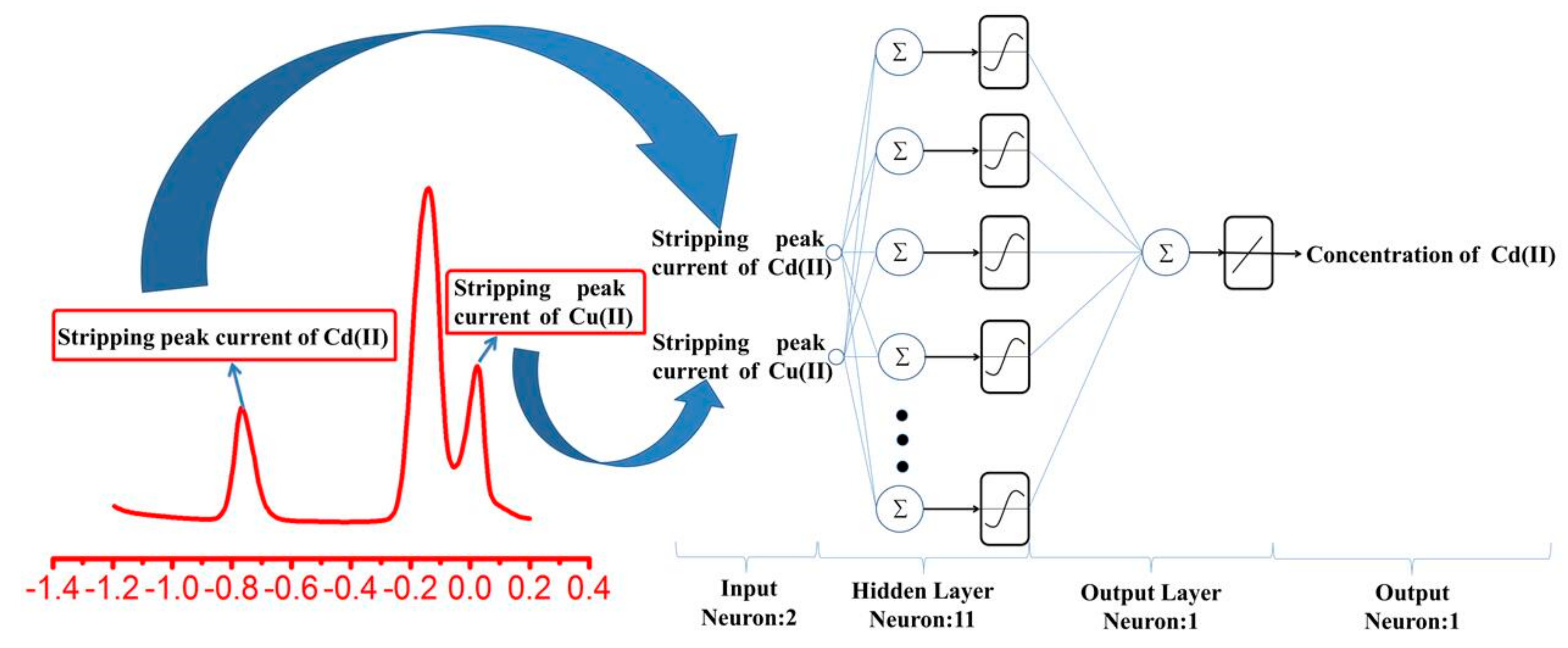
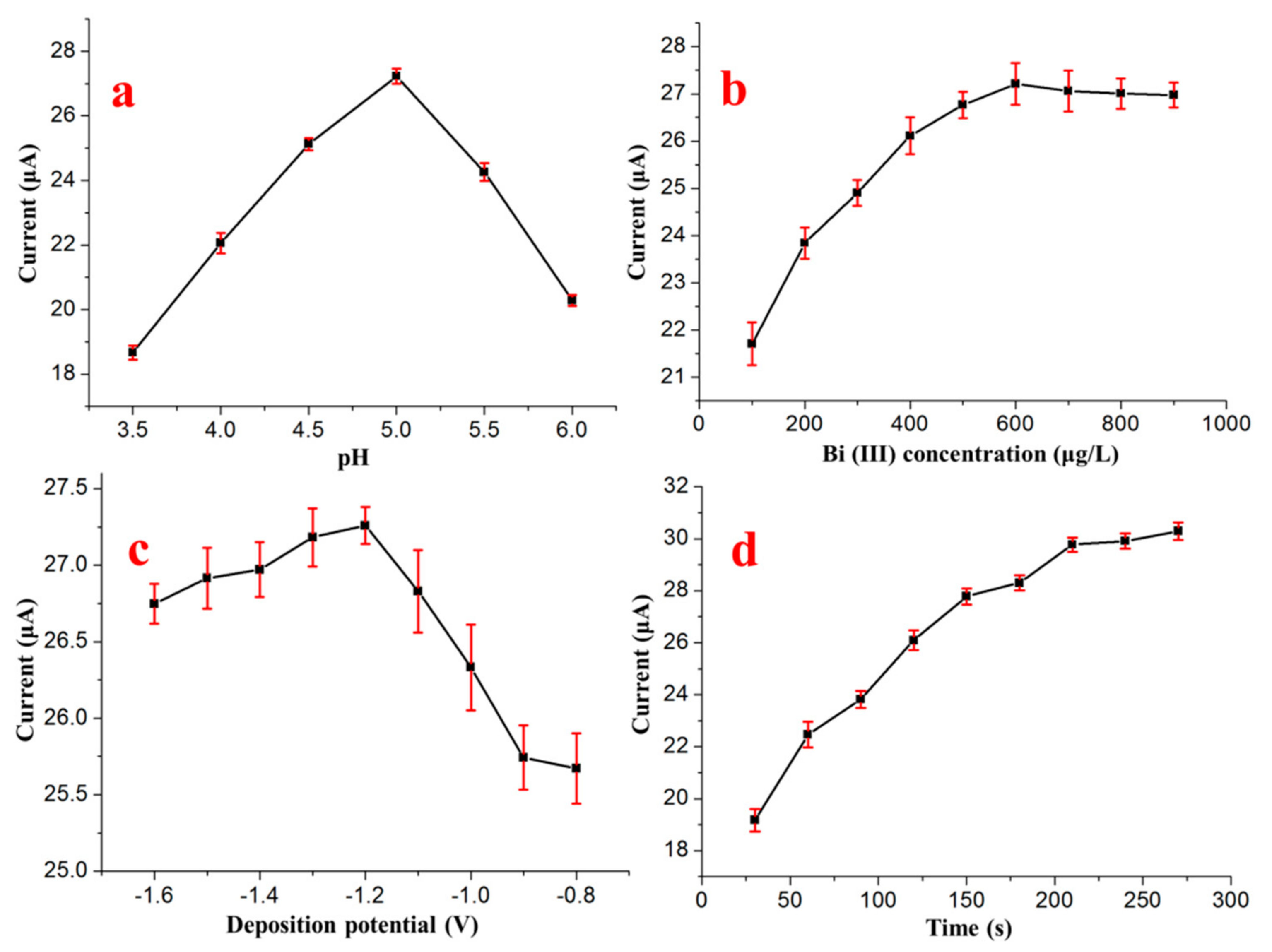


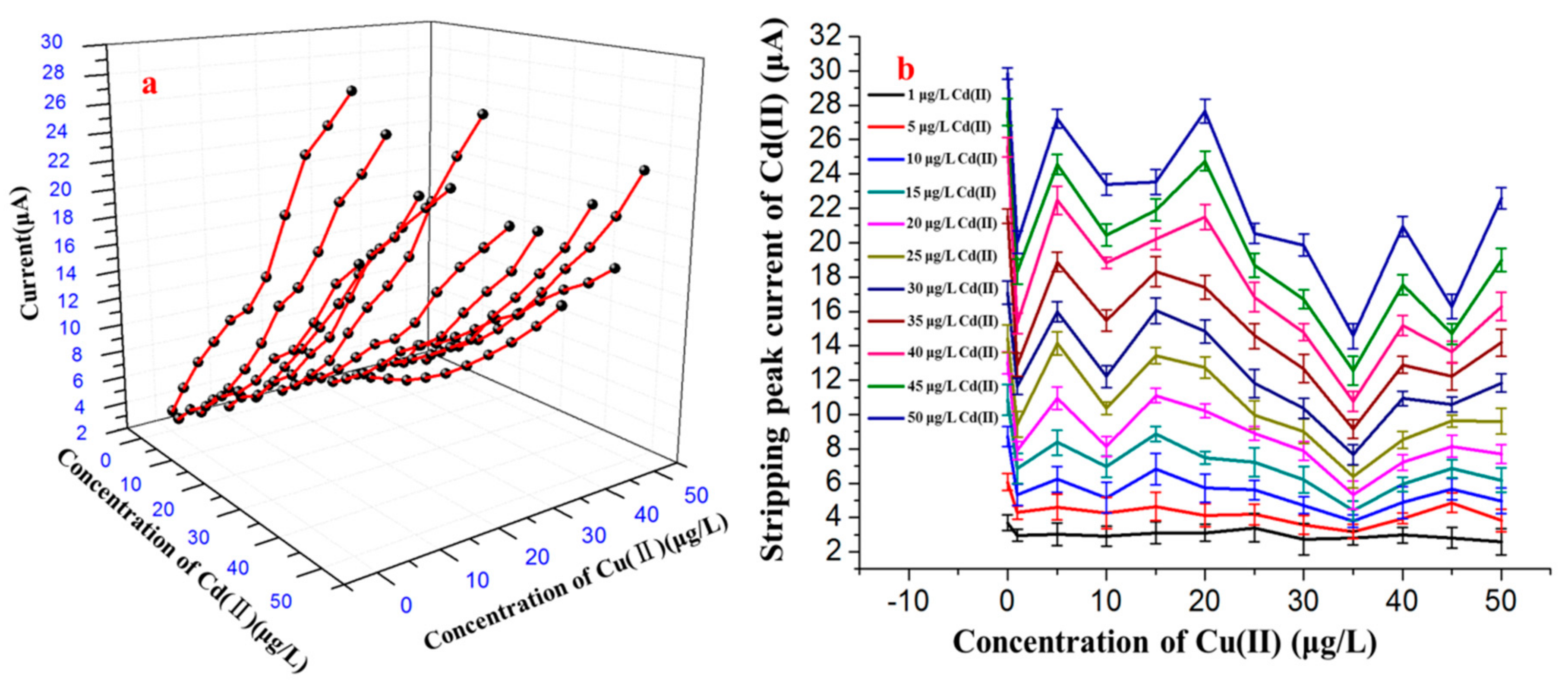

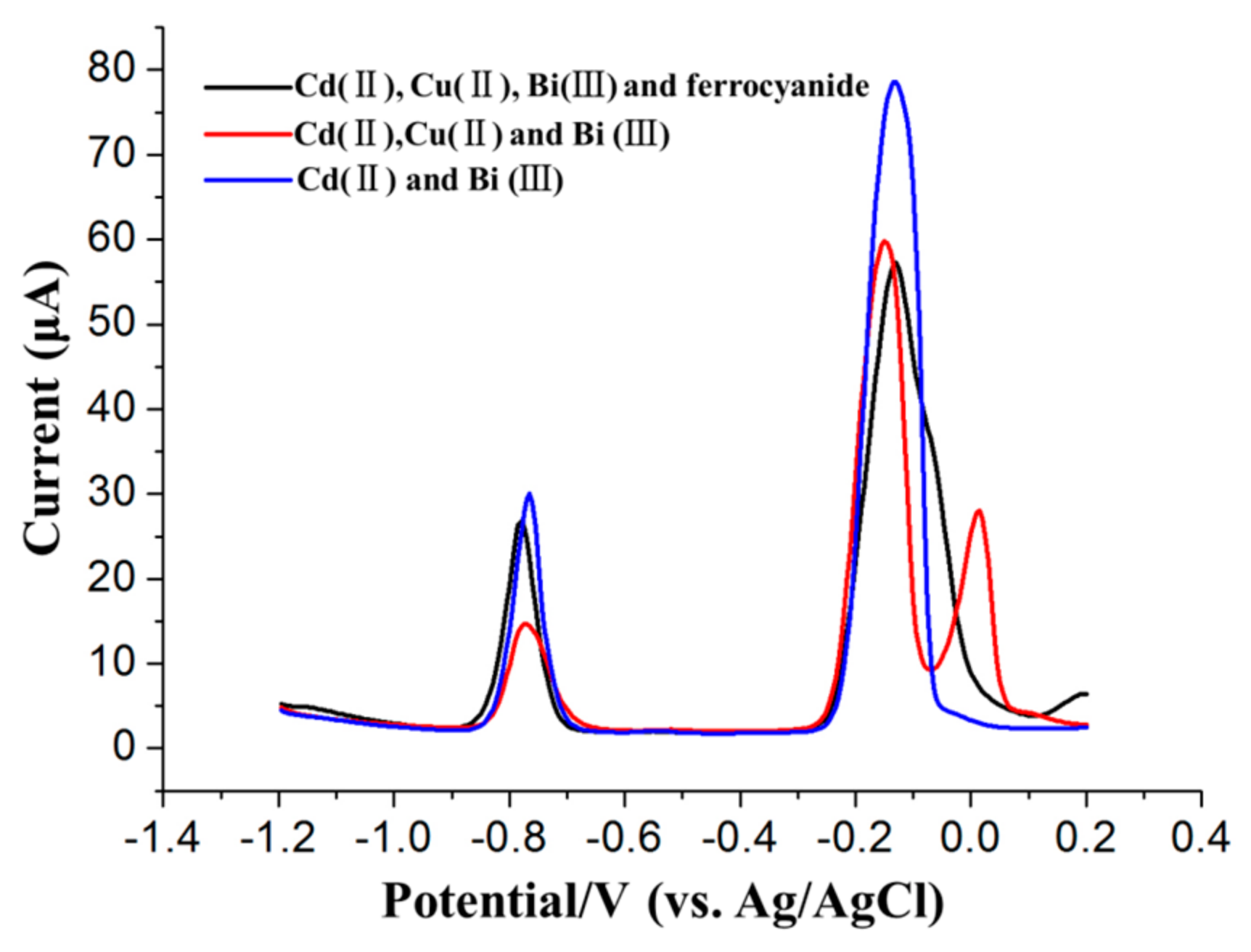
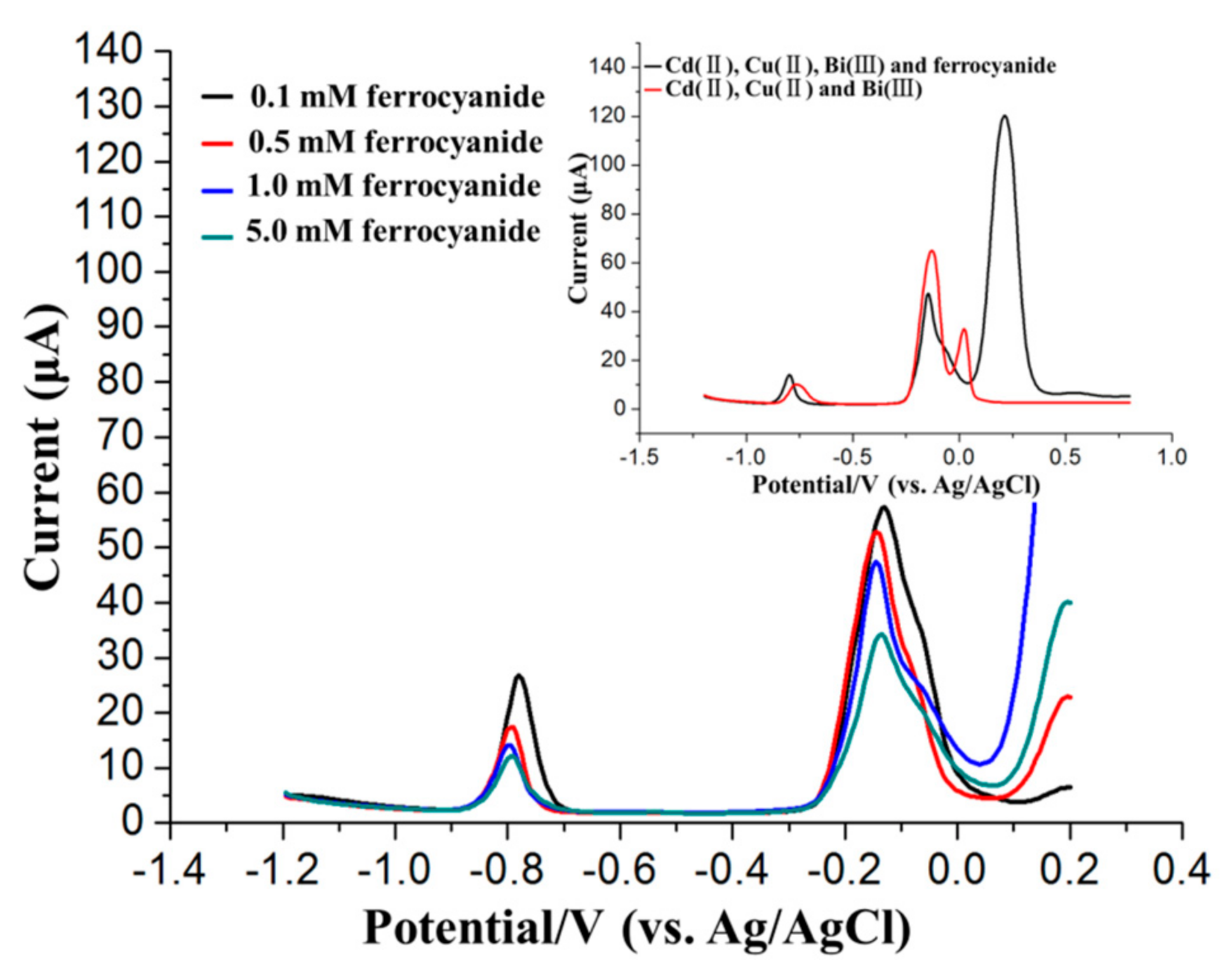

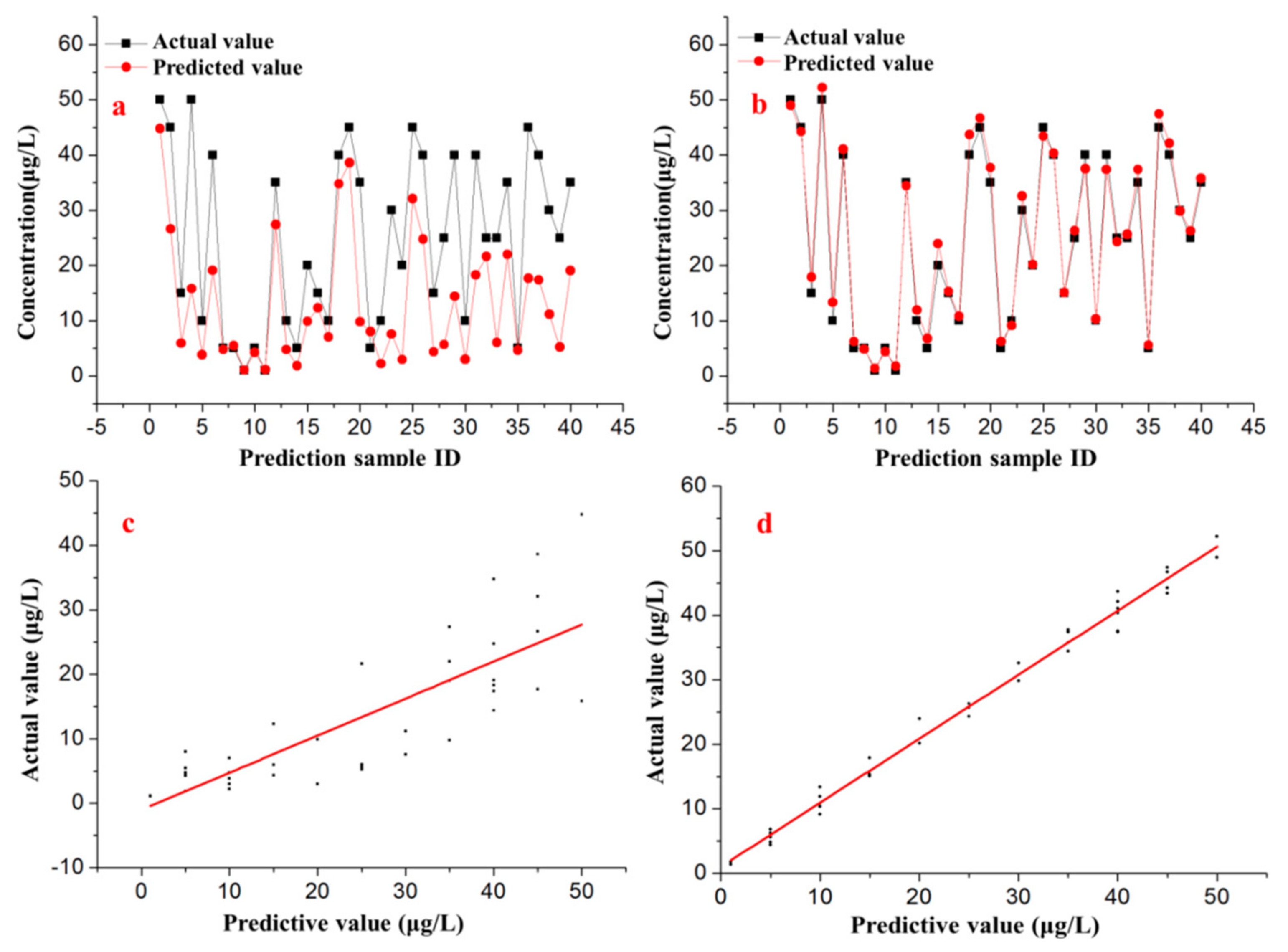
| Data Set | MAE (μg/L) | RMSE (μg/L) |
|---|---|---|
| Training dataset | 1.22 | 1.48 |
| Testing dataset | 1.42 | 1.76 |
| Prediction Model | MAE (μg/L) | RMSE (μg/L) | R2 |
|---|---|---|---|
| Direct calibration (with ferrocyanide) | 11.67 | 14.77 | 0.64 |
| Binary linear regression (without ferrocyanide) | 4.07 | 4.92 | 0.84 |
| Binary nonlinear regression (without ferrocyanide) | 2.85 | 3.77 | 0.92 |
| ANN (without ferrocyanide) | 1.42 | 1.76 | 0.99 |
| Sample No. | Added (μg/L) | Found by SWASV-ANN (μg/L) | Found by SAM (μg/L) | Recovery (%) (SWASV-ANN) | Recovery (%) (SAM) |
|---|---|---|---|---|---|
| Cd2+ | Cd2+ | Cd2+ | Cd2+ | ||
| 1 | - | 4.67 | 4.96 | 0.00 | 0.00 |
| 4.0 | 8.39 | 9.14 | 93.00 | 101.75 | |
| 8.0 | 12.82 | 13.06 | 101.88 | 98.75 | |
| 2 | - | 2.54 | 2.73 | 0.00 | 0.00 |
| 5.0 | 7.63 | 7.82 | 99.60 | 97.80 | |
| 10.0 | 12.45 | 12.95 | 98.10 | 102.20 | |
| 3 | - | 8.16 | 8.28 | 0.00 | 0.00 |
| 10.0 | 17.98 | 18.39 | 98.20 | 91.10 | |
| 15.0 | 23.02 | 23.31 | 99.07 | 100.20 |
© 2017 by the authors. Licensee MDPI, Basel, Switzerland. This article is an open access article distributed under the terms and conditions of the Creative Commons Attribution (CC BY) license (http://creativecommons.org/licenses/by/4.0/).
Share and Cite
Zhao, G.; Wang, H.; Liu, G. Direct Quantification of Cd2+ in the Presence of Cu2+ by a Combination of Anodic Stripping Voltammetry Using a Bi-Film-Modified Glassy Carbon Electrode and an Artificial Neural Network. Sensors 2017, 17, 1558. https://doi.org/10.3390/s17071558
Zhao G, Wang H, Liu G. Direct Quantification of Cd2+ in the Presence of Cu2+ by a Combination of Anodic Stripping Voltammetry Using a Bi-Film-Modified Glassy Carbon Electrode and an Artificial Neural Network. Sensors. 2017; 17(7):1558. https://doi.org/10.3390/s17071558
Chicago/Turabian StyleZhao, Guo, Hui Wang, and Gang Liu. 2017. "Direct Quantification of Cd2+ in the Presence of Cu2+ by a Combination of Anodic Stripping Voltammetry Using a Bi-Film-Modified Glassy Carbon Electrode and an Artificial Neural Network" Sensors 17, no. 7: 1558. https://doi.org/10.3390/s17071558
APA StyleZhao, G., Wang, H., & Liu, G. (2017). Direct Quantification of Cd2+ in the Presence of Cu2+ by a Combination of Anodic Stripping Voltammetry Using a Bi-Film-Modified Glassy Carbon Electrode and an Artificial Neural Network. Sensors, 17(7), 1558. https://doi.org/10.3390/s17071558






